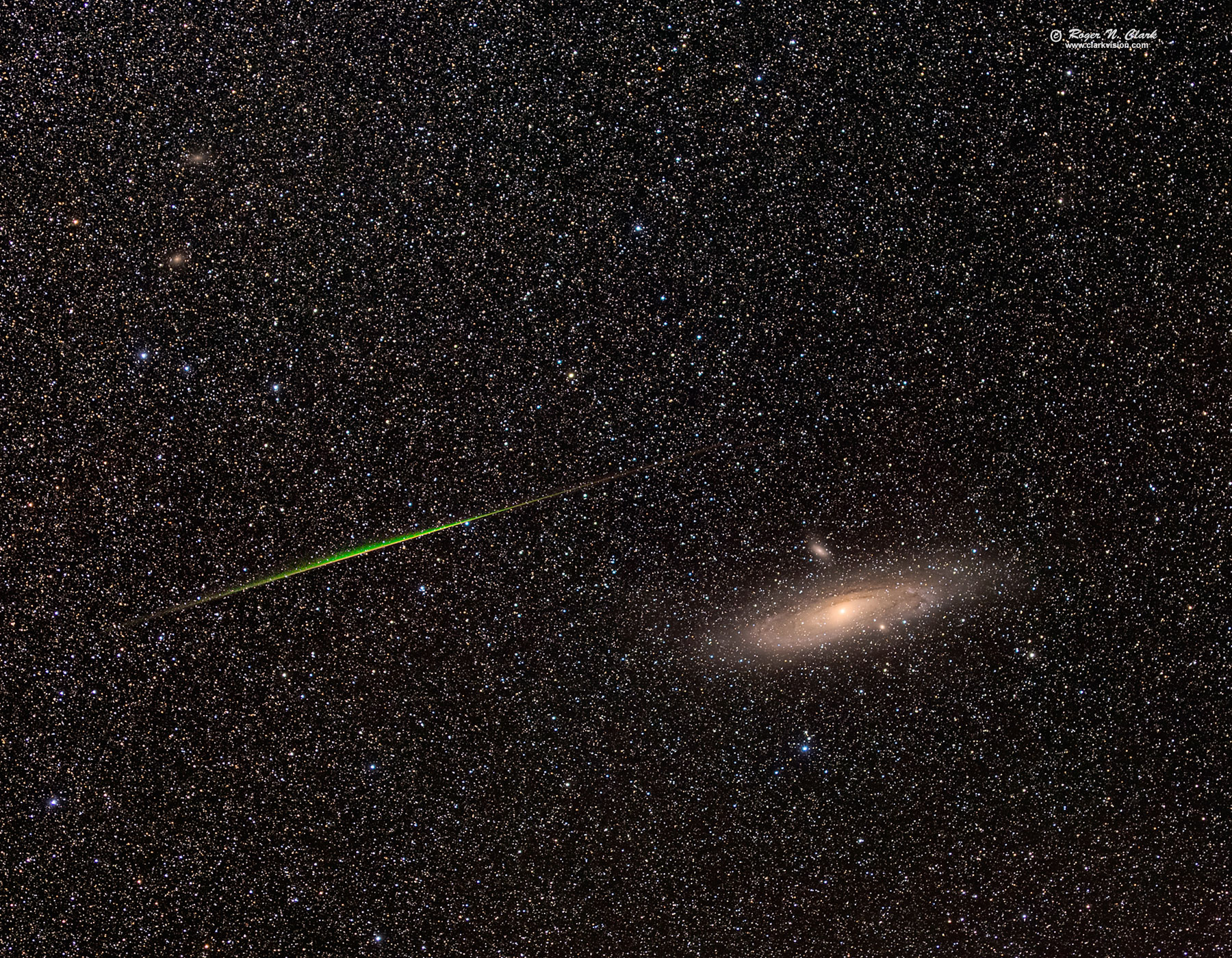| Home | Galleries | Articles | Reviews | Best Gear | New | About | Contact | Gallery Index | Previous |
Next |

| Home | Galleries | Articles | Reviews | Best Gear | New | About | Contact | Gallery Index | Previous |
Next |

The Andromeda Galaxy, M31, is a spectacular large galaxy and close to the Milky Way. This image shows the dust in the spiral arms, and the different populations of stars in the core of the galaxy (population I, yellower stars) and in the outer spiral arms (less yellow stars, population II). The long angular length of the galaxy shown here is about 6 times the angular diameter of the full Moon. M32 is a small fuzzy spot to the lower right od the core of M31. M110 is the elliptical galaxy just above M31. Toward the upper left corner of the image are two other satellite galaxies, NGC 147 (above), and NGC 185 (below NGC 147). A green Perseid meteor was recorded streaking from the left to right.
Technical. This image was obtained with a Canon 6D 20-megapixel digital camera and a Sigma 105mm f/1.4 DG HSM Art Lens at f/1.4 and ISO 1600. Daylight white balance for natural color. No dark frame subtraction, no flat fields. Tracking with an Fornax Lighttrack II and no guiding. Total exposure was 20 minutes (forty 30-second exposures). The full resolution image is 12.88 arc-seconds / pixel and the crop shown here is at half that scale, 25.8 arc-seconds / pixel Faintest star: about 15.3 in a single exposure, 16.9 in the 20 image stack.
Post processing: stretched with rnc-color-stretch. Also see Astrophotography Image Processing Basic Work Flow.
This is a natural color image. The high dynamic range of astrophotos must be stretched to bring out the range of details the camera recorded. But the typical image stretch process loses color for brighter subjects (e.g. stars and the brighter parts of the galaxy become whiter as they are made brighter). This image uses an algorithm that does not lose color during the stretch. Colors were checked against known color photometry.
Color at the darkest levels is difficult to determine due to sky brightness adding to the signal from objects beyond the Earth's atmosphere. The image was obtained under very dark skies (Bortle class 1) with sky brightness: red = 21.8, green = 22.1, blue = 22.4 magnitudes / sq. arc-second. Because of this low sky brightness, color of the spiral arms of M31 and faint outer regions is likely very good. Note the spiral arm color is not the intense blue we commonly see from digital cameras--that is due to processing methods that results in a blackpoint error.
The Exposure Factors, CEF, CEFA are measures of the relative amounts of light received from a subject. It can be used to fairly compare wildly different lens/telescope apertures and exposure times. For this image:
Modern DSLRs like the 7D Mark II include on sensor dark current suppression and low fixed pattern noise at ISOs around 1600 and higher, making no need for dark frame subtraction. Modern raw converters correct for light fall-off and also correct for hot/dead/stuck pixels. This makes processing low light images easy: simply align and average.
To learn how to obtain stunning images like this, please visit my Extensive Articles on Photography .
See my review of the Canon 7D Mark II and why it is so good for astrophotography: Canon 7D Mark II sensor analysis.
Keywords to this image = astrophoto-1 galaxy Messier night low-light digital_astro meteor canon_6d rnc-color-stretch
Image ID: m31+meteor_105mm-av40-20min-c08.13.2018-img5552-91.e-0.5xrc1-1800s.jpg
| Home | Galleries | Articles | Reviews | Best Gear | Science | New | About | Contact |
Last updated November 03, 2025